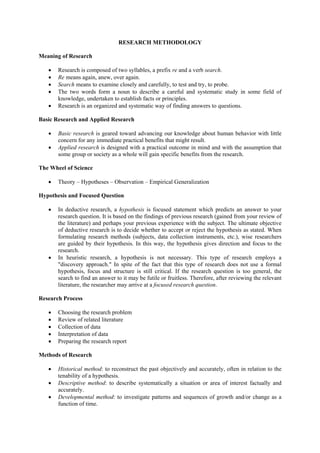
Research methodology (1)
- 1. RESEARCH METHODOLOGY Meaning of Research • Research is composed of two syllables, a prefix re and a verb search. • Re means again, anew, over again. • Search means to examine closely and carefully, to test and try, to probe. • The two words form a noun to describe a careful and systematic study in some field of knowledge, undertaken to establish facts or principles. • Research is an organized and systematic way of finding answers to questions. Basic Research and Applied Research • Basic research is geared toward advancing our knowledge about human behavior with little concern for any immediate practical benefits that might result. • Applied research is designed with a practical outcome in mind and with the assumption that some group or society as a whole will gain specific benefits from the research. The Wheel of Science • Theory – Hypotheses – Observation – Empirical Generalization Hypothesis and Focused Question • In deductive research, a hypothesis is focused statement which predicts an answer to your research question. It is based on the findings of previous research (gained from your review of the literature) and perhaps your previous experience with the subject. The ultimate objective of deductive research is to decide whether to accept or reject the hypothesis as stated. When formulating research methods (subjects, data collection instruments, etc.), wise researchers are guided by their hypothesis. In this way, the hypothesis gives direction and focus to the research. • In heuristic research, a hypothesis is not necessary. This type of research employs a "discovery approach." In spite of the fact that this type of research does not use a formal hypothesis, focus and structure is still critical. If the research question is too general, the search to find an answer to it may be futile or fruitless. Therefore, after reviewing the relevant literature, the researcher may arrive at a focused research question. Research Process • Choosing the research problem • Review of related literature • Collection of data • Interpretation of data • Preparing the research report Methods of Research • Historical method: to reconstruct the past objectively and accurately, often in relation to the tenability of a hypothesis. • Descriptive method: to describe systematically a situation or area of interest factually and accurately. • Developmental method: to investigate patterns and sequences of growth and/or change as a function of time.
- 2. • Case and field method: to study intensively the background, current status, and environmental interactions of a given social unit. • Correlational method: to investigate the extent to which variations in one factor correlate with variations in one or more other factors based on correlation coefficient. • Casual-comparative or “Ex post facto” method: to investigate possible cause-and-effect relationships by observing some existing consequence and looking back through the data for plausible casual factors. • True experimental method: to investigate possible cause-and-effect relationships by exposing one or more experimental groups to one or more treatment conditions and comparing the results to one or more control groups not receiving the treatment, random assignment being essential. • Quasi-experimental method: to investigate the conditions of the true experiment in a setting which does not allow the control or manipulation of all relevant variables. • Action research: to develop skills or new approaches and to solve problems with direct application to the classroom or other applied setting. Variables A variable is a measurable characteristic that varies. There are three common variable types: • Dependent variables: show the effect of manipulating or introducing the independent variables. The variation in the dependent variable depends on the variation in the independent variable. • Independent variables: are those that the researcher has control over. This "control" may involve manipulating existing variables (e.g., modifying existing methods of instruction) or introducing new variables (e.g., adopting a totally new method for some sections of a class) in the research setting. • Control variables: research studies are very complex processes. It is not possible to consider every variable in a single study. Therefore, the variables that are not measured in a particular study must be held constant, neutralized/balanced, or eliminated, so they will not have a biasing effect on the other variables. Variables that have been controlled in this way are called control variables. Parametric Analysis • Description and examination of relationships between different parameters, such as energy and economic factors. • It is an excellent way to get accurate information about the influence of all parameters on the design objectives, such as system performance with respect to other variables. • Together with sensitivity analysis, it enables the engineer to identify the key parameters and know where the focus should be. Sensitivity Analysis • It is the study of how the variation (uncertainty) in the output of a mathematical model can be apportioned, qualitatively or quantitatively, to different sources of variation in the input of a model. • In more general terms, uncertainty and sensitivity analyses investigate the robustness of a study when the study includes some form of mathematical modelling. While uncertainty analysis studies the overall uncertainty in the conclusions of the study, sensitivity analysis tries to identify what source of uncertainty weights more on the study's conclusions. • It looks at the effect of varying the inputs of a mathematical model on the output of the model itself. Sensitivity tests help people to understand dynamics of a system. SamHui/081105
